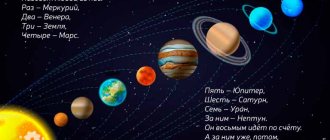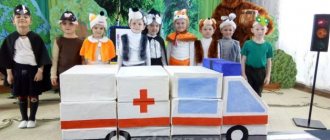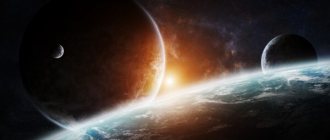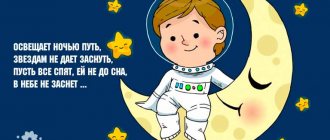How to easily remember the order of planets in the sky
In order, all the planets can be named by any of us: One - Mercury, Two - Venus, Three - Earth, Four - Mars. Five is Jupiter, Six is Saturn, Seven is Uranus, followed by Neptune.
Think back to how you memorized the colors of the rainbow as a child. The same principle can be applied to the names of the planets. Construct a phrase in which each word begins with the same letter as a planet in the solar system in the order of its location from the Sun. For example:
We are Mercury We will meet Venus Tomorrow My Earth Mars Young Jupiter Satellite Saturn Flying away Uranus Not for long Pluto
This is just an example, in fact, you can come up with anything, as long as it is close to your child’s spirit and he easily remembers the entire sentence. Now that we have figured out exactly how to present any information to children, we can move on to the direct knowledge that you will teach your young astronomers.
Finally, an interesting and simple story for children about what the solar system is. The solar system is all the cosmic bodies that revolve around the Sun according to their clearly defined trajectories. These include 8 planets and their satellites (their composition is constantly changing, as some objects are discovered, others lose their status), many comets, asteroids and meteorites. History of the emergence of planets There is no definite opinion on this matter, there are only theories and guesses. According to the most common opinion, about 5 billion years ago, one of the clouds of the Galaxy began to shrink towards the center and formed our Sun. The formed body had a tremendous gravitational force, and all the particles of gas and dust around began to connect and stick together into balls (these are the current planets). The Sun as a star and the center of the Solar System The planets in their orbits revolve around a huge star called the Sun. The planets themselves do not emit any heat, and if it were not for the light of the Sun that they reflect, then life on Earth would never have arisen. There is a certain classification of stars, according to which the Sun is a yellow dwarf, approximately 5 billion years old. Satellites of planets The solar system does not consist only of planets; it also includes natural satellites, including the well-known Moon. In addition to Venus and Mercury, each planet has a certain number of satellites, today there are more than 63. New celestial bodies are constantly being discovered thanks to photographs taken by automatic spacecraft. They are capable of detecting even the smallest satellite with a diameter of only 10 km (Leda, Jupiter). Characteristics of each planet of the solar system 1. Mercury. This planet is closest to the Sun; in the entire system it is considered the smallest. Mercury has a hard surface, like all four inner planets (those closest to the center). It has the highest rotation speed. During the day, the planet practically burns under the sun's rays (+350˚), and freezes at night (-170˚). 2. Venus. This planet is more similar to Earth than others in its size and brightness. There are always a lot of clouds around it, which makes observation difficult. The entire surface of Venus is a hot rocky desert. 3. Earth is the only planet on which there is water, and therefore life. It has an ideal location in relation to the Sun: close enough to receive light and heat in the right quantities, and far enough not to get burned by the rays. The Earth has one satellite - the Moon. 4. Mars. Some scientists have suggested that life also exists on this planet because it has a number of similarities with Earth. But numerous studies have found no signs of life there. At the moment, two natural satellites of Mars are known: Phobos and Deimos. 5. Jupiter is the largest planet in the solar system, 10 times larger than Earth in diameter and 300 times larger in mass. Jupiter consists of hydrogen, helium and other gases and has 16 satellites. 6. Saturn is the most interesting planet for children, as it has rings that are formed from dust, stones and ice. There are three main rings around Saturn, each about 30 meters thick. 7. Uranium. This planet also has rings, but they are much more difficult to see and only appear at certain times. The main feature of Uranus is its manner of rotation, performed in the “lying on its side” mode. 8. Neptune. Astronomy today calls this planet the last in the solar system. Neptune was discovered only in 1989, since it is located very far from the Sun. Its surface looks blue from space, which cannot but amaze us. Until 2006, there were 9 planets, including Pluto. But according to the latest scientific data, this space object is no longer called a planet. It’s a pity... Although, it has become easier for children to remember.
Poem about planets for children
Children's poems: to kindergarten | about nature | about vegetables | about fruits | about animals | about school | about the days of the week | about colors
Shape: cool | beautiful | sms | short
An astrologer lived on the Moon. He kept track of the planets: MERCURY - one, VENUS - two, three - EARTH, Four - MARS, Five - JUPITER, Six - SATURN, Seven - URANUS, Eight - NEPTUNE, Nine - the farthest PLUTO, Who If he doesn’t see it, get out!
2
In order, all the planets can be named by any of us: One - Mercury, Two - Venus, Three - Earth, Four - Mars. Five is Jupiter, Six is Saturn, Seven is Uranus, followed by Neptune. He is the eighth in a row. And behind it, then, is the ninth planet called Pluto.
3
What luminaries are called planets? There are stars in the sky, but they are very strange. They walk across the sky among other Other, real, twinkling stars. And are they stars? — We are concerned about the question. A wandering star wandering across the sky is not a star at all, but a planet! Planets, unlike stars, are cold - They do not shine, they only reflect light, alas! And this light is bright, but of different shades. They are different in some way, I guess. Different surfaces - that's the secret. Let's study the planets and look for the answer.
4
Elusive, little Mercury is the first to meet solar storms. The second, behind him, flies Venus With a heavy, dense atmosphere. And the third, the carousel spins, Our earthly cradle. The fourth is Mars, the rusty planet, the red-orange one. And then they rush, like a swarm of bees, the asteroids in their orbit. The fifth is Jupiter, very large and clearly visible in the starry sky. Sixth - Saturn, in chic rings, Charming, under the rays of the sun. The seventh - Uranus, lay down like a couch potato, Because his long path is difficult. The eighth is Neptune, the fourth gas giant. He is a dandy in a beautiful blue shirt. Pluto, Charon, the ninth in the system, pass the time in the darkness as a duet.
5
There is no air in outer space, and nine different planets are circling there. And the Sun is a star in the very center of the system, And we are all connected by gravity.
The sun-shine bubbles like a volcano, Seethes like a boiling cauldron, incessantly, Prominences fly up like a fountain, Gives life and warmth to everyone tirelessly.
The sun-star is a huge ball, emitting light like a fire. Well, the planets reflect that light, they adore the Sun!
Many planets fly around the Sun. Maybe people live on them? Come on, you and I will get into the rocket, Let's rush away from the Sun in the blue darkness!
Maybe Mercury will please us? And he will bring us friends from the whole class!
6
An astrologer lived on the Moon. He kept track of the planets: MERCURY - one, VENUS - two, three - EARTH, Four - MARS, Five - JUPITER, Six - SATURN, Seven - URANUS, Eight - NEPTUNE, Nine - the farthest PLUTO, Who If he doesn’t see it, get out!
7
The black velvet of the sky is embroidered with stars. A bright path runs across the sky. It spreads easily from edge to edge, as if someone spilled milk across the sky. But, of course, there is no milk or juice in the sky, We see our star system from the side. This is how we see the Galaxy. Our distant native light is space for astronautics for many thousands of years.
8
Neptune in blue radiance - “sea deity” Found, in calculated coordinates, - Halle. The calculations of Adams and Le Verrier became a triumph for all whose works revealed the laws of heaven. The eighth from the Sun, thirty times further than our Earth. Much denser, among the giant planets. Thirteen companions are known from his family, He is in rings made of dust particles, elegant. Methane atmosphere, winds, clouds, One of the satellites, in reverse motion, With the surface only slightly covered with nitrogen It is clear what gravity was enough for.
9
Look! Do you know who this wanderer is? It is called by the name of God - the messenger. The planet closest to the Sun - Let's get acquainted - is Mercury. He loves to hide in the rays Faster than anyone else and very strongly From the heat in solar ovens The surface is hot for a long day. From the wind of the Sun there is only the atmosphere. And where the kingdom of dark night is, the temperature stays at about minus two hundred. By the way, it looks like a double of the Moon, a neighbor. The landscapes around us are familiar, Meteorites often fall, and the composition of the soil is even similar.
10
Venus is a very hot planet. Do you want to be more precise? I'll say it differently. Four hundred seventy-five Celsius. In short, it's so hot that you could hang yourself. Yes, and it cannot be any other way. Everyone knows this: Venus is the second planet from the Sun. From Earth it is bright white.
In terms of mass and overall dimensions, Venus and the Earth are generally similar. Believe me, this is why astronomers of the world call Venus the Sister Planet. Only it is younger than the Earth. Scientists made measurements... And it turned out that the Earth is eight times older than Venus. It's not a big deal, but it's nice.
A year on Venus is two-thirds that of Earth. This is not little, but not much either. The coolest number of hours in a day is - There are two thousand eight hundred of them. The sun rises on Venus in the west. Maybe you will say: “Here you have it!” But this is an astronomical fact: Venus rotates somehow differently.
Its atmosphere is carbon dioxide, plus a small admixture of nitrogen. The pressure on the ears is beyond measure - Almost ninety-three atmospheres. Such pressure, although not fatal, is close to the limit for a person. Dive about ninety meters into the water - it’s very easy to become a Venusian.
11
The fourth is Mars, red-orange, Wandering in the sky along the ecliptic constellations. Two tiny satellites, discovered once, Under the names: Phobos, Deimos - as retribution Two times smaller than Venus And the gravitational force is small The compositions of the atmosphere are similar, But it is very rarefied And rarely completely transparent From long dust storms and light clouds. There are riverbeds that have long been lost. Volcanoes are sleeping, mountains have risen high, Less heat from the Sun - and the water has frozen in permafrost. Twice: its path is longer, years. But the days are counted like on Earth.
12
In order, all the planets can be named by any of us: One - Mercury, Two - Venus, Three - Earth, Four - Mars. Five is Jupiter, Six is Saturn, Seven is Uranus, followed by Neptune. He is the eighth in a row. And behind it, then, is the ninth planet called Pluto.
13
An astrologer lived on the Moon. He kept track of the planets: MERCURY - one, VENUS - two, three - EARTH, Four - MARS, Five - JUPITER, Six - SATURN, Seven - URANUS, Eight - NEPTUNE, Nine - the farthest PLUTO, Who If he doesn’t see it, get out!
14
In order, all the planets can be named by any of us: One - Mercury, Two - Venus, Three - Earth, Four - Mars. Five is Jupiter, Six is Saturn, Seven is Uranus, followed by Neptune. He is the eighth in a row. And behind it, then, is the ninth planet called Pluto.
15
Space fairy tale (fragment) Space is painted black, Since there is no atmosphere, There is neither night nor day. There is no earthly blue here, Here the views are strange and wonderful: And the stars are all visible at once, And the Sun and the Moon.
A star is visible in the north, and it is called the Polar Star. She is a reliable friend of people, And two Ursa bears are with her Among the cosmic lights They all walk in a row.
More poems: < 129 130 131 132 133 134 135 136 137 138 139 >









